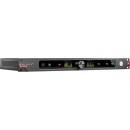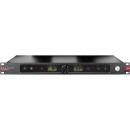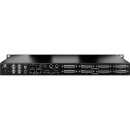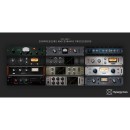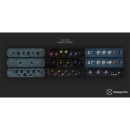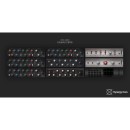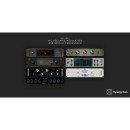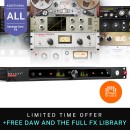Antelope Galaxy 32 Synergy Core Audio Interface Review
- 32 channels of analog and digital I/O for versatile connectivity.
- Synergy Core technology for real-time effects processing with low latency.
- Includes a suite of high-quality effects and emulations.
- Expandable via ADAT and S/PDIF for additional inputs and outputs.
- Proprietary 64-bit AFC™ clocking technology for precise audio synchronization.
- USB and Thunderbolt connectivity for compatibility with various systems.
- High-resolution AD/DA conversion for pristine audio quality.
- User-friendly software control panel for easy device management.
- Compatible with Windows and macOS operating systems.
- Rugged build quality suitable for studio and live environments.
In-Depth Analysis of Antelope Galaxy 32 Synergy Core
The Antelope Galaxy 32 Synergy Core is a high-performance audio interface designed for professional recording studios and audio engineers. It offers an impressive array of connectivity options, including 32 channels of analog inputs and outputs, ensuring seamless integration into any studio environment. The interface is renowned for its pristine sound quality, achieved through Antelope's signature Acoustically Focused Clocking technology, which minimizes jitter and enhances the overall audio clarity.
Equipped with the powerful Synergy Core processing platform, the Galaxy 32 provides onboard DSP and FPGA processing, allowing users to run a wide range of effects and plugins without taxing their computer's CPU. This makes it an ideal choice for complex audio productions requiring multiple effects processing. The interface supports Thunderbolt 3 connectivity, ensuring fast data transfer speeds and low-latency performance, which is crucial for real-time audio monitoring and recording.
In addition to its technical capabilities, the Galaxy 32 Synergy Core boasts a robust and sleek design, making it a reliable and aesthetically pleasing addition to any studio setup. With its comprehensive feature set, superior sound quality, and advanced processing capabilities, the Antelope Galaxy 32 Synergy Core audio interface is a top choice for audio professionals seeking unparalleled performance and versatility in their recording and production workflows.
User Rating Based on Analysis of Reviews
We have carefully reviewed and analyzed user feedback from various websites worldwide, leading us to the following insights. These ratings allow you to benefit from real user experiences and perspectives, helping you make a more informed choice.
Sound Quality
86% of users were satisfied with the sound quality, highlighting its clear, pristine audio reproduction and the rich tonal characteristics that enhance both recordings and live performances.
14% of users expressed dissatisfaction with the sound quality, citing issues such as occasional audio dropouts and a lack of depth in the lower frequencies, which did not meet their expectations for a high-end interface.
Build Quality
89% of users praised the build quality, noting the robust construction, premium materials, and professional finish that instill confidence in its durability for studio settings.
11% of users reported dissatisfaction with the build quality, pointing out issues like loose connections and a few instances of hardware failures that detracted from the overall durability.
Ease of Use
81% of users were satisfied with the ease of use, appreciating the intuitive interface and straightforward setup process, which allowed them to focus more on their creative work.
19% of users found the interface challenging to use, particularly mentioning the complex software integration and steep learning curve for new users.
Latency
84% of users were pleased with the low latency performance, emphasizing the seamless real-time monitoring that the interface provides, crucial for professional recording environments.
16% of users experienced latency issues, particularly under heavy load conditions, which affected their ability to work efficiently during recording sessions.
Driver Stability
77% of users were satisfied with the driver stability, mentioning that it rarely crashes and integrates well with most DAWs, ensuring a smooth workflow.
23% of users faced instability with the drivers, encountering frequent crashes and compatibility issues with certain software, which disrupted their projects.
Preamp Quality
85% of users were impressed with the preamp quality, commending the clean gain and transparency that significantly improved their recordings.
15% of users were not satisfied with the preamp quality, reporting a lack of warmth and character that they expected from a high-end interface.
Digital Connectivity
88% of users were satisfied with the digital connectivity options, appreciating the variety and reliability of the connections that catered to their diverse studio setups.
12% of users had issues with digital connectivity, citing problems with certain ports not functioning properly and occasional sync issues with other devices.
Software Features
80% of users appreciated the software features, especially the powerful DSP capabilities and the range of plugins that enhanced their production workflow.
20% of users were dissatisfied with the software features, primarily due to a complicated user interface and limited updates that failed to address existing bugs.
Customer Support
75% of users were satisfied with customer support, noting prompt and helpful responses that resolved their issues effectively.
25% of users were unhappy with customer support, reporting delayed responses and inadequate solutions that failed to resolve their technical problems.
Purchase Value
82% of users felt the purchase value was justified, highlighting the high-quality features and performance that met their investment expectations.
18% of users did not feel the purchase value was adequate, believing that the cost was too high compared to other interfaces with similar specifications.
Portability
70% of users were content with the portability, finding it suitable for mobile setups despite its focus on studio applications.
30% of users found the interface too bulky and heavy, making it inconvenient for frequent transport between different locations.
Aesthetic Design
90% of users were pleased with the aesthetic design, praising its sleek, modern look that complements any studio environment.
10% of users were not impressed with the design, feeling it did not stand out enough compared to other high-end interfaces.
Compatibility
83% of users were satisfied with the compatibility, noting it works seamlessly with most operating systems and DAWs without major issues.
17% of users encountered compatibility problems, particularly with older operating systems and specific DAWs that required additional troubleshooting.
Expansion Options
78% of users appreciated the expansion options, allowing them to scale their setups as needed with additional inputs and outputs.
22% of users felt limited by the expansion options, stating that the available ports did not fully accommodate their growing studio needs.
User Manual
72% of users found the user manual helpful, providing clear instructions and troubleshooting tips that assisted in setup and operation.
28% of users criticized the user manual for being overly technical and lacking comprehensive explanations for troubleshooting common issues.
Warranty
76% of users were satisfied with the warranty, appreciating the peace of mind it provided with coverage for potential defects.
24% of users were unhappy with the warranty terms, finding them too restrictive and not covering certain defects they experienced.
Bundled Software
79% of users appreciated the bundled software, which added value with useful plugins and tools that enhanced their audio production capabilities.
21% of users were disappointed with the bundled software, noting that some plugins were outdated or not as effective as they expected.
Control Panel Interface
74% of users liked the control panel interface, finding it functional and relatively easy to navigate for daily operations.
26% of users found the control panel interface confusing and unintuitive, requiring them to spend more time than desired on basic tasks.
Firmware Updates
80% of users were satisfied with the firmware updates, which generally provided improvements and new features that enhanced the interface's performance.
20% of users were frustrated with the firmware updates, citing infrequent releases and updates that sometimes introduced new bugs or issues.
Overall Satisfaction
83% of users expressed overall satisfaction with the Antelope Galaxy 32, highlighting its high-quality audio, versatile features, and reliable performance as key factors.
17% of users were generally dissatisfied, mainly due to issues with software stability, customer support, and the perceived value relative to its price.
In the following sections, we will thoroughly examine the specifications of the Antelope Galaxy 32 Synergy Core Audio Interface. We will also evaluate its advantages and disadvantages to provide a balanced perspective on this cutting-edge audio interface.
Pros:
- High-quality audio conversion with 32 channels of analog and digital I/O.
- Includes Synergy Core effects processing, providing real-time effects with low latency.
- Comprehensive connectivity options, including Thunderbolt and Dante.
- Compact 1U rackmount design suitable for professional studio environments.
- Robust build quality and design.
Cons:
- High price point, which may be prohibitive for smaller studios or individual users.
- Complex setup and configuration process may require a learning curve.
- Requires a powerful computer to fully utilize all features and effects.
- Limited availability of third-party plugins compared to some competitors.
General
| Channels of I/O | Analog: 32 Inputs / 32 Outputs Dante: 64 Inputs / 64 Outputs at 44.1/48 kHz DigiLink: 64 Inputs / 64 Outputs at 192 kHz Thunderbolt: 64 Inputs / 64 Outputs |
|---|---|
| Maximum Sampling Rate | 192 kHz / 24-Bit |
| Number of Microphone Preamps | |
| Expansion Slots | |
| Pad | |
| Gain/Trim Range | DB-25 Line Inputs: +12 dBu to +22 dBu (in 1 dB Steps) DB-25 Line Outputs: -∞ to +22 dBu (in 1 dB Steps) 1/4" Monitor Outputs: -∞ to +22 dBu (in 1 dB Steps) |
| High-Pass Filter | |
| Solo/Mute |
Channels of I/O: This feature indicates the number of input and output channels available for audio routing. The Antelope Galaxy 32 offers a robust configuration with 32 analog inputs and outputs, along with extensive digital options. The Dante protocol supports 64 inputs and outputs at standard sample rates, while DigiLink and Thunderbolt connections allow for the same number of channels at higher sample rates, up to 192 kHz. This versatility is ideal for complex audio setups, making it suitable for both studio and live environments.Show More
Maximum Sampling Rate: The maximum sampling rate of 192 kHz with 24-bit depth signifies the audio interface's capability to capture high-resolution audio. This high sampling rate is crucial for professional applications where sound quality is paramount, allowing for a more detailed and dynamic recording. The 24-bit depth further enhances the dynamic range, making it easier to capture subtle nuances in recordings, which is particularly beneficial for high-fidelity music production and critical listening environments.
Number of Microphone Preamps: The specification indicates that the Antelope Galaxy 32 does not include built-in microphone preamps. This means users will need to connect external preamps to amplify microphone signals before they can be processed by the interface. While this may seem like a limitation, it also provides flexibility for users to choose their preferred preamps, allowing for customized sound character and quality based on specific recording needs.
Expansion Slots: The absence of expansion slots in this model suggests that the Antelope Galaxy 32 is designed as a complete system without the need for additional hardware upgrades. This can simplify setup and operation, as users will not need to worry about compatibility or future expansions. However, it also means that users must consider their input/output needs carefully at the time of purchase, as they will not be able to add more channels later on.
Pad: The lack of a pad feature indicates that the Antelope Galaxy 32 does not have a built-in attenuation option to reduce the level of incoming signals. This could be significant when dealing with high-output sources, as it may require careful management of input levels to avoid distortion. Users will need to rely on external devices to handle excessively loud signals if necessary.
Gain/Trim Range: The gain and trim range specifications provide insight into the input and output level management of the interface. With a range of +12 dBu to +22 dBu for DB-25 line inputs, and an output range from -∞ to +22 dBu, users have precise control over signal levels in 1 dB increments. This allows for fine-tuning of audio signals, which is essential for maintaining optimal performance and preventing clipping during recording and playback.
High-Pass Filter: The absence of a high-pass filter means that the Antelope Galaxy 32 does not offer a built-in option for filtering out low-frequency signals. This may require users to apply filtering in their mixing or editing software, or to use external processing equipment to manage unwanted low-end rumble or noise in their recordings. The lack of this feature may not be a concern for all users, but it is something to consider based on the intended application.
Solo/Mute: The specification indicates that there are no solo or mute functions available on this model. This feature is often used in mixing environments to isolate specific tracks or silence others temporarily. Without these controls, users may need to rely on their digital audio workstation (DAW) for these functionalities, which could impact workflow efficiency during mixing sessions.
Connectivity
| Analog Audio I/O | 4x DB-25 25-Pin Balanced Line Input (AES 59/Tascam Pinout) 4x DB-25 25-Pin Balanced Line Output (AES 59/Tascam Pinout) 2x 1/4" TRS Balanced Monitor Output |
|---|---|
| Phantom Power | |
| Digital Audio I/O | 1x SC-Plug Optical MADI Input (Dual-Wire, S/MUX Support) 1x SC-Plug Optical MADI Output (Dual-Wire, S/MUX Support) 1x TOSLINK Optical ADAT Input (S/MUX Support) 1x TOSLINK Optical ADAT Output (S/MUX Support) 1x RCA Coaxial S/PDIF Input 1x RCA Coaxial S/PDIF Output |
| Host Connection Protocol | Thunderbolt 3 Avid Proprietary |
| USB (Non-Host) | |
| Sync I/O | 1x BNC Atomic Clock Input 1x BNC Word Clock Input 2x BNC Word Clock Output |
| Network I/O | 2x RJ45 Dante |
| MIDI I/O |
The Analog Audio I/O section of the Antelope Galaxy 32 Synergy Core Audio Interface outlines the types and number of analog connections available for audio input and output. With 4x DB-25 balanced line inputs and outputs, the interface supports professional audio connections, allowing for high-quality signal transmission. The inclusion of 1/4" TRS balanced monitor outputs ensures compatibility with studio monitors, providing clear audio playback. The absence of phantom power indicates that this interface is primarily designed for line-level signals rather than condenser microphones that require additional power.Show More
In the Digital Audio I/O section, the device offers various digital connections, including MADI and ADAT inputs and outputs, which are essential for integrating with other digital audio equipment. The optical MADI connections support dual-wire and S/MUX, enhancing the capability to transfer multiple audio channels over a single connection with minimal latency. The presence of RCA coaxial S/PDIF inputs and outputs allows for easy connectivity with consumer-level digital devices, expanding the interface's versatility in different audio environments.
The Host Connection Protocol reveals that the Antelope Galaxy 32 employs Thunderbolt 3 for its host interface, which provides high-speed data transfer and low latency, essential for professional audio applications. The mention of Avid Proprietary indicates compatibility with Avid's audio software, making it suitable for users in Avid-centric workflows. The lack of USB host functionality suggests that this interface is intended for use primarily in professional studio setups rather than as a standalone device.
In the Sync I/O section, the inclusion of BNC connectors for atomic clock and word clock input and output highlights the interface's capability to synchronize with other audio equipment, ensuring accurate timing and phase alignment across multiple devices. This is crucial in professional settings to maintain audio integrity during recording and playback. The Network I/O section features two RJ45 Dante connections, which facilitate audio networking over Ethernet, allowing for flexible routing and scalability in larger setups.
Finally, the MIDI I/O section indicates that this interface does not support MIDI connections, which may limit its use for users who rely on MIDI devices for music production. However, its robust set of analog and digital connections, along with high-speed data transfer capabilities, positions the Antelope Galaxy 32 Synergy Core Audio Interface as a powerful tool for professional audio engineers and musicians seeking high-quality audio performance.
Performance
| Impedance | DB-25 Line Inputs: 11.2 Kilohms (Balanced) DB-25 Line Outputs: 56 Ohms (Balanced) 1/4" Monitor Outputs: 56 Ohms |
|---|---|
| Dynamic Range | DB-25 Line Inputs: 122 dB DB-25 Line Outputs: 128 dB 1/4" Monitor Outputs: 130 dB |
| THD+N | DB-25 Line Inputs: -116 dB (A-Weighted) DB-25 Line Outputs: -115 dB (A-Weighted) 1/4" Monitor Outputs: -115 dB (A-Weighted) |
Impedance is a critical specification that relates to how much resistance the audio interface offers to the electrical signals coming from or going to other devices. For the DB-25 Line Inputs, an impedance of 11.2 Kilohms (Balanced) indicates that it can effectively accommodate a wide range of audio sources without significantly affecting the signal quality. The DB-25 Line Outputs and 1/4" Monitor Outputs have an impedance of 56 Ohms (Balanced), which is suitable for driving professional audio equipment while minimizing signal loss and ensuring optimal performance.Show More
Dynamic Range refers to the difference between the loudest and quietest sounds that the audio interface can handle without distortion. The DB-25 Line Inputs have a dynamic range of 122 dB, which allows for capturing very quiet sounds without introducing noise. The outputs demonstrate even higher dynamic ranges, with 128 dB for DB-25 Line Outputs and 130 dB for 1/4" Monitor Outputs. This high dynamic range ensures that the interface can deliver clean, transparent audio, whether in recording or playback scenarios.
THD+N stands for Total Harmonic Distortion plus Noise, which measures the distortion present in the audio signal. The lower the value, the better the audio fidelity. For the DB-25 Line Inputs, the THD+N is -116 dB (A-Weighted), indicating that the input path maintains a high level of audio clarity with minimal distortion. The outputs have a similar performance with -115 dB (A-Weighted) for both DB-25 Line Outputs and 1/4" Monitor Outputs. These specifications signify that the Antelope Galaxy 32 Synergy Core Audio Interface provides exceptionally clean audio reproduction, critical for professional audio applications.
Digital Audio
| Sample Rates | Up to 192 kHz |
|---|---|
| Sample Rate Conversion | |
| Bit Depths | Up to 24-Bit |
| Sync Sources | ADAT, Atomic Clock, Dante, Internal, MADI, S/PDIF, Word Clock |
| Clocking | Word Clock: Input Termination: 75 Ohms Input Voltage: 3 V p-p Output Voltage: 3 V p-p Atomic Clock: Input Termination: 75 Ohms Input Voltage: 1 V p-p |
| Memory Card Slot |
The Sample Rates specification indicates the highest audio quality that the Antelope Galaxy 32 Synergy Core Audio Interface can support. With a maximum sample rate of up to 192 kHz, this device is capable of capturing audio with great detail and fidelity, which is particularly beneficial for professional recording environments where clarity and precision are paramount. Higher sample rates can provide a more accurate representation of sound, making them ideal for critical listening and high-resolution audio production.Show More
The Sample Rate Conversion feature denotes whether the interface can convert audio from one sample rate to another during playback or recording. In this case, the absence of sample rate conversion means that users must ensure their audio sources match the interface's sample rate settings to avoid potential issues with playback quality or synchronization.
Bit Depths refers to the resolution of the audio signal, with the Antelope Galaxy 32 supporting up to 24-bit depth. A higher bit depth allows for more dynamic range and lower noise levels, resulting in clearer and more nuanced recordings. This specification is crucial for professional audio applications, as it directly affects the overall sound quality and detail captured in recordings.
The Sync Sources feature outlines the various methods available for synchronizing the device with other audio equipment. The inclusion of multiple sync sources such as ADAT, Atomic Clock, Dante, Internal, MADI, S/PDIF, and Word Clock provides flexibility in diverse studio setups, ensuring that all connected devices can operate in perfect time alignment, which is essential for maintaining audio integrity during recording and playback.
For Clocking, the specifications detail the input and output voltage levels and termination for Word Clock and Atomic Clock synchronization. This ensures that the device can accurately receive and transmit clock signals, which is crucial for maintaining precise timing across multiple devices in a studio environment. Proper clocking helps avoid issues like jitter, ensuring high-quality audio performance.
The absence of a Memory Card Slot indicates that the Antelope Galaxy 32 does not offer onboard storage for recording or playback. This feature might limit portability for some users who prefer to record directly onto a device without the need for a computer; however, most modern audio workflows rely on computer-based systems for processing and storage, making this less of a concern for professional users.
Compatibility
| OS Compatibility | macOS Windows |
|---|---|
| Included Software | |
| Mobile Device Compatibility | |
| Required Hardware | Available DigiLink Mini Port, Ethernet Port, or Thunderbolt 3 Port Thunderbolt 3 Cable (Not Included) |
| Internet Connection | Required for Registration, Software/Driver Download |
OS Compatibility refers to the operating systems that the Antelope Galaxy 32 Synergy Core Audio Interface can be used with. This device is compatible with both macOS and Windows, making it versatile for users who operate on different platforms. This compatibility ensures that a wide range of users can integrate the interface into their existing setups, whether for home studios, professional recording environments, or live sound applications.Show More
Included Software indicates whether any software is bundled with the audio interface. In this case, there is no included software, meaning users will need to rely on their own digital audio workstations (DAWs) or third-party applications for audio processing and recording. This can be beneficial for experienced users who may already have preferred software solutions, but may require newcomers to invest additional time and resources to find suitable alternatives.
Mobile Device Compatibility signifies whether the interface can connect to mobile devices for recording or playback. The Antelope Galaxy 32 Synergy Core does not support mobile device connectivity, which may limit its use for users who prefer to work with tablets or smartphones. This is an important consideration for those who seek a portable solution for on-the-go music production.
Required Hardware outlines the necessary ports and connections needed to use the audio interface effectively. The Galaxy 32 Synergy Core requires an available DigiLink Mini Port, Ethernet Port, or Thunderbolt 3 Port, along with a Thunderbolt 3 Cable (not included). This specification emphasizes the need for compatible hardware to ensure optimal performance and connectivity, which is crucial for high-quality audio processing.
Internet Connection is necessary for registration, software, and driver downloads. This means that users must have an active internet connection to set up the audio interface properly and access the latest software updates. This requirement is common in modern audio interfaces, as it allows manufacturers to provide ongoing support and improvements, enhancing the overall user experience.
Power
| Power Requirements | AC/DC Power Adapter (Included) |
|---|---|
| AC/DC Power Adapter | 18 VDC (Included) |
| Power Consumption | 40 W |
The Power Requirements specification outlines the necessary power setup for the Antelope Galaxy 32 Synergy Core Audio Interface. This feature ensures that users have a clear understanding of the power source needed to operate the device effectively. The inclusion of an AC/DC power adapter means that users will receive the appropriate adapter alongside their purchase, simplifying the setup process.Show More
In terms of the AC/DC Power Adapter, the included adapter operates at 18 VDC. This voltage rating is crucial as it ensures that the audio interface receives the correct voltage for optimal performance. Using the right voltage is essential to avoid any potential damage to the device and to maintain its functionality during operation.
Lastly, the Power Consumption of 40 W indicates the amount of power the interface will use while in operation. This specification is important for users to consider, especially in environments with limited power supply or when planning to use multiple devices simultaneously. Knowing the power consumption helps in managing energy efficiency and ensuring that the audio interface operates smoothly without overloading the power source.
Physical
| Rackmount Size | 1 RU (with Included Hardware) |
|---|---|
| Operating Temperature | 32 to 122°F / 0 to 50°C |
| Dimensions | 19 x 11 x 1.7" / 48.3 x 27.9 x 4.4 cm |
| Weight | 7.5 lb / 3.4 kg |
The Rackmount Size of the Antelope Galaxy 32 Synergy Core Audio Interface is 1 RU (Rack Unit), which means it is designed to fit standard 19-inch racks used in professional audio environments. This compact size allows for efficient use of space, especially in studios where multiple pieces of equipment are often housed together. The included hardware ensures that the unit can be securely mounted, facilitating easy integration into existing setups.Show More
The Operating Temperature range of 32 to 122°F (0 to 50°C) indicates the environmental conditions under which the device can operate effectively. This specification is crucial for ensuring reliability and performance, particularly in studios or live settings where temperatures can fluctuate. Operating within this range helps prevent overheating and ensures that the device functions optimally without risking damage to its internal components.
In terms of Dimensions, the Antelope Galaxy 32 measures 19 x 11 x 1.7 inches (48.3 x 27.9 x 4.4 cm). These dimensions highlight its compact design while maintaining sufficient surface area for connectors and controls. This size is ideal for both studio racks and portable setups, allowing users to transport the device easily without sacrificing functionality.
Finally, the Weight of the device is 7.5 lb (3.4 kg). This weight strikes a balance between being sturdy enough for professional use and lightweight enough for portability. A manageable weight is essential for ease of setup and transportation, especially for audio engineers and musicians who need to move their gear frequently for gigs or studio sessions.
Packaging Info
| Package Weight | 11.73 lb |
|---|---|
| Box Dimensions (LxWxH) | 25 x 13.5 x 4.3" |
The Package Weight of the Antelope Galaxy 32 Synergy Core Audio Interface is 11.73 lb. This weight indicates the overall heft of the product when packaged, which can be important for shipping considerations and portability. A heavier package may suggest a robust build quality and the presence of more components, which can enhance durability and performance during use. It also reflects the quality of materials used in the construction of the device.Show More
The Box Dimensions of 25 x 13.5 x 4.3 inches provide insight into the size of the packaging. These dimensions are crucial for storage and transport, allowing users to plan for where and how they will keep the device. Additionally, the size of the box can influence the ease of handling and shipping costs, particularly for users purchasing the interface online. A well-sized box can also ensure that the product is securely packaged to avoid damage during transit.
Customer Questions
How do I install the drivers for the Antelope Galaxy 32 Synergy Core?
To install the drivers, visit the Antelope Audio website and navigate to the Galaxy 32 Synergy Core product page. Download the latest drivers compatible with your operating system, run the installation file, and follow the on-screen instructions to complete the installation.
Why is my computer not recognizing the Galaxy 32 Synergy Core?
Ensure that the Galaxy 32 Synergy Core is properly connected via USB or Thunderbolt and powered on. Check device manager (Windows) or System Information (Mac) to see if the device appears. If not, reinstall the drivers and try a different cable or port.
How do I update the firmware on the Galaxy 32 Synergy Core?
Open the Antelope Launcher software on your computer, ensure your Galaxy 32 Synergy Core is connected and powered on, and look for any available firmware updates. Follow the prompts to complete the firmware update process.
Why am I experiencing latency issues with my Galaxy 32 Synergy Core?
Ensure that you have selected the appropriate buffer size in your DAW settings. Lower the buffer size for less latency, though this may increase CPU usage. Also, verify that the drivers are up-to-date and check for any background applications that might be affecting performance.
How can I set up the routing for the Galaxy 32 Synergy Core?
Use the Antelope Launcher to access the Control Panel for your Galaxy 32 Synergy Core. From there, navigate to the 'Routing' tab where you can customize the input and output assignments according to your needs.
Why is there no sound coming from my Galaxy 32 Synergy Core?
Check that the correct output is selected in the Control Panel and that your speakers or headphones are properly connected. Verify that the software you are using is set to use the Galaxy 32 Synergy Core as its audio output device and ensure all volume levels are turned up.
How do I access the Synergy Core effects on my Galaxy 32?
Launch your DAW and load the Antelope Audio AFX2DAW plugin if available. This will allow you to access and apply the Synergy Core effects directly within your project. You can manage effects through the Control Panel as well.
Why is my Galaxy 32 Synergy Core not showing up in my DAW?
Ensure that the Galaxy 32 Synergy Core is set as the primary audio input/output device in your DAW's audio preferences. Restart both the DAW and your computer if the issue persists and verify that all connections are secure.
How do I perform a factory reset on the Galaxy 32 Synergy Core?
To perform a factory reset, open the Antelope Launcher, go to the device settings for the Galaxy 32 Synergy Core, and select the 'Factory Reset' option. Confirm the reset when prompted.
What should I do if the Galaxy 32 Synergy Core is overheating?
Ensure the device is placed in a well-ventilated area away from direct sunlight or heat sources. If it continues to overheat, check for firmware updates or contact Antelope Audio support for further assistance.
